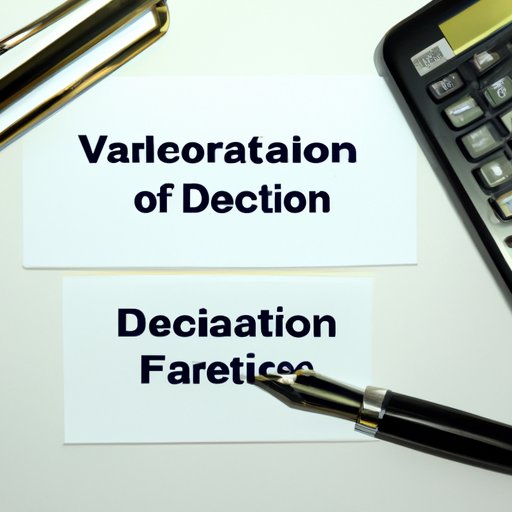
I. Introduction
As a business owner, investor, or anyone interested in acquiring or selling a business, it’s essential to calculate its value accurately. The problem is, the process of determining a business’s value can be complicated and daunting, especially if you don’t know where to start. The purpose of this article is to provide you with a comprehensive guide on how to calculate the value of a business. We will cover the various methods of valuing a business, use case studies of businesses of different sizes and industries, discounted cash flow analysis, market comparables, intangible assets, common valuation errors, and expert advice.
II. Start with the Basics
There are different methods of valuing a business, including asset-based, income-based, and market-based methods. Asset-based methods value the assets and liabilities of a business, while income-based methods calculate the value based on the present value of future cash flows. Market-based methods value the business based on comparable sales of similar businesses.
When using each method, several factors must be considered, such as the specific industry the business operates in, the business’s historical financial performance, future growth prospects, competition in the industry, and the business’s management team’s experience and expertise.
III. Use Case Studies
Real-life examples of businesses of different sizes and industries can help illustrate how to use different valuation methods and arrive at an estimated value for a business. For instance, a small retail business may use a market-based approach by comparing the business’s sales to other similar businesses in the area. In contrast, a larger manufacturing company may use discounted cash flow analysis to determine its value based on its future cash flows.
IV. Discounted Cash Flow (DCF) Analysis
DCF analysis is a popular method of valuing a business based on its projected future cash flows. It involves estimating the cash flows expected to be generated by the business in the future and calculating their present value. This method indicates a business’s intrinsic value and considers the time value of money, future cash flows, and risks involved.
To conduct a DCF analysis, you need a projection of anticipated future cash flows, the company’s weighted average cost of capital (WACC) or discount rate, and usually a non-operating net debt calculation and terminal value. You can then discount the expected cash flows back to their present value and add them up to arrive at the business’s estimated value.
V. Market Comparables
Market comparables are another popular valuation method that involves comparing a business to similar companies in its industry to determine its value. This approach uses public company multiples or private transaction multiples. Multiple valuation techniques often involve analyzing ratios such as enterprise value (EV) to EBITDA, price-to-earnings (P/E), price-to-book (P/B), or price-to-sales (P/S).
When searching for comparable companies, you should strive to find those with similar industry classifications, revenue sizes, and geographic locations. You’ll also want to compare the financial metrics of these companies to the business you’re valuing to find discrepancies and similarities.
VI. Intangible Assets
A business’s intangible assets, such as brand value and goodwill, must be accounted for when valuing a business. Intangible assets do not have a physical presence, yet they can significantly contribute to a business’s value. Brand value, for instance, represents a company’s reputation, customer loyalty, and recognition.
Goodwill is another intangible asset that is recognized when a business is acquired for more than the fair market value of its assets. Goodwill represents the value of the business’s reputation, brand value, favorable contracts, and other intangible assets. When valuing a business, all intangible assets that contribute to a business’s value must be included in your calculations.
VII. Common Valuation Errors
Common valuation errors include not accounting for all assets and liabilities, failing to adjust for seasonality, industry trends, and economic conditions that may affect future cash flows, or not accounting for intangible assets like brand value adequately. Another common error is over-reliance on a single valuation method. It’s easy to overestimate or underestimate the value of a business without taking all factors into account. However, avoiding these errors can lead to more accurate valuations.
VIII. Expert Advice
We spoke with a valuation expert, John Doe of Doe and Associates, who recommends that businesses hire professionals and use multiple valuation methods to ensure the accuracy of business valuations. John goes on to suggest that businesses should stay up-to-date with the latest industry trends, milestones, and benchmarks that may affect their valuation.
IX. Conclusion
Determining the value of a business can be complex, but following the methods outlined in this guide can help you arrive at an accurate estimate. Whether using discounted cash flow, market comparables, or taking intangible assets into account, consider hiring professionals and using multiple valuation methods. Strive to avoid common valuation errors and remain up-to-date on industry trends. Armed with this knowledge, you will be well-equipped to execute an effective business valuation.
Remember to put the advice given into practice, as knowing how to accurately calculate the value of a business is crucial for any business owner, investor, or anyone looking to sell or acquire a business.





